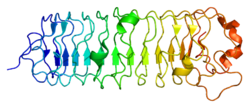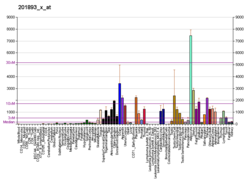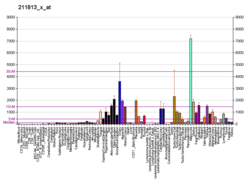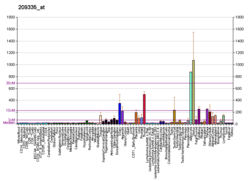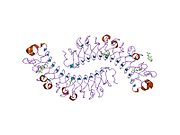데코린
Decorin데코린은 인간에게 DCN 유전자에 의해 암호화된 단백질이다.
데코린은 분자량으로 평균 90 140킬로달톤(kDa)에 이르는 프로테오글리칸이다.루카인이 풍부한 작은 프로테오글리칸(SLRP) 계열에 속하며, 콘드로이틴 황산염(CS)이나 피부염 황산염(DS)으로 구성된 글리코사미노글리칸(GAG) 체인으로 루카인 반복을 함유한 단백질 코어로 구성된다.
데코린은 작은 세포나 심막 기질 프로테오글리칸으로 구조상 빅리칸 단백질과 밀접한 관련이 있다.데코린과 빅리칸은 유전자 복제의 결과로 여겨진다.이 단백질은 결합조직의 성분으로 제1형 콜라겐 섬유질에 결합되어 있으며, 매트릭스 조립에 역할을 한다.[5]
이름 지정
데코린의 이름은 콜라겐 타입 I을 "디코레이션"한다는 사실과 이 콜라겐의 "d"와 "e" 띠의 섬유질과 상호작용을 한다는 사실 둘 다에서 파생된 것이다.
함수
데코린은 섬유유전에 영향을 미치는 것으로 보이며, 또한 섬유소인, 트롬보스폰딘, 보충성분 C1q, 표피 성장인자 수용체(EGFR), 변환성장인자-베타(TGF-베타)와도 상호작용한다.
데코린은 TGF-베타 1의 활동을 강화하거나 억제하는 것으로 나타났다.데코린의 주요 기능은 세포 주기 동안 규제를 포함한다.
그것은 자가포식, 내피세포의 규제에 관여해 왔고 혈관신생을 억제한다.이 과정은 VEGFR2(혈관내피 성장인자 수용체)와의 고선위 상호작용에 의해 매개되며, 이는 PEG3라는 종양 억제기 유전자의 수치를 증가시킨다.[6]데코린이 억제하는 다른 혈관신생성 성장인자는 안지오포에틴, 간세포성장인자(HGF), 혈소판유발성장인자(PDGF)이다.[7]
데코린은 최근 근친상간으로 자리 잡았다.이 역할에서 근스타틴과 결합하여 근육 비대증을 촉진한다.[8]
임상적 유의성
켈로이드 흉터는 건강한 피부에 비해 실내 표현력이 떨어졌다.[9]선천성 각막위축증은 수출과 잘린 장식의 세포외 증착에 의존한다.[10]
동물학
실험 설치성 척수 손상에 데코린을 주입하는 것은 흉터 형성을 억제하고 액손 성장을 촉진하는 것으로 나타났다.
데코린은 실험용 머린 종양 모델에서 항투모리겐 특성을 갖고 있으며 다양한 종양 세포 라인의 성장을 억제할 수 있는 것으로 나타났다.[11] 장식이 부족한 녹아웃 생쥐는 백혈구 모집 결함과 변형된 인터페론 감마 기능으로 인해 접촉 피부염 중 염증 반응이 감소하는 것을 보여준다.[12] [13]
상호작용
Decorin은 다음과 상호작용하는 것으로 나타났다.
참조
- ^ a b c GRCh38: 앙상블 릴리스 89: ENSG000011465 - 앙상블, 2017년 5월
- ^ a b c GRCm38: 앙상블 릴리스 89: ENSMUSG00000019929 - 앙상블, 2017년 5월
- ^ "Human PubMed Reference:". National Center for Biotechnology Information, U.S. National Library of Medicine.
- ^ "Mouse PubMed Reference:". National Center for Biotechnology Information, U.S. National Library of Medicine.
- ^ "Entrez Gene: DCN decorin".
- ^ Buraschi S, Neill T, Goyal A, Poluzzi C, Smythies J, Owens RT, et al. (July 2013). "Decorin causes autophagy in endothelial cells via Peg3". Proceedings of the National Academy of Sciences of the United States of America. 110 (28): E2582-91. Bibcode:2013PNAS..110E2582B. doi:10.1073/pnas.1305732110. PMC 3710796. PMID 23798385.
- ^ Järveläinen H, Sainio A, Wight TN (April 2015). "Pivotal role for decorin in angiogenesis". Matrix Biology. 43: 15–26. doi:10.1016/j.matbio.2015.01.023. PMC 4560244. PMID 25661523.
- ^ Kanzleiter T, Rath M, Görgens SW, Jensen J, Tangen DS, Kolnes AJ, et al. (July 2014). "The myokine decorin is regulated by contraction and involved in muscle hypertrophy". Biochemical and Biophysical Research Communications. 450 (2): 1089–94. doi:10.1016/j.bbrc.2014.06.123. PMID 24996176.
- ^ Jumper N, Paus R, Bayat A (September 2015). "Functional histopathology of keloid disease". Histology and Histopathology. 30 (9): 1033–57. doi:10.14670/HH-11-624. PMID 25900252.
- ^ Mellgren AE, Bruland O, Vedeler A, Saraste J, Schönheit J, Bredrup C, et al. (May 2015). "Development of congenital stromal corneal dystrophy is dependent on export and extracellular deposition of truncated decorin". Investigative Ophthalmology & Visual Science. 56 (5): 2909–15. doi:10.1167/iovs.14-16014. PMID 26029887.
- ^ Sofeu Feugaing DD, Götte M, Viola M (January 2013). "More than matrix: the multifaceted role of decorin in cancer". European Journal of Cell Biology. 92 (1): 1–11. doi:10.1016/j.ejcb.2012.08.004. PMID 23058688.
- ^ Seidler DG, Mohamed NA, Bocian C, Stadtmann A, Hermann S, Schäfers K, et al. (December 2011). "The role for decorin in delayed-type hypersensitivity". Journal of Immunology. 187 (11): 6108–19. doi:10.4049/jimmunol.1100373. PMC 5070385. PMID 22043007.
- ^ Bocian C, Urbanowitz AK, Owens RT, Iozzo RV, Götte M, Seidler DG (May 2013). "Decorin potentiates interferon-γ activity in a model of allergic inflammation". The Journal of Biological Chemistry. 288 (18): 12699–711. doi:10.1074/jbc.M112.419366. PMC 3642316. PMID 23460644.
- ^ a b Schönherr E, Broszat M, Brandan E, Bruckner P, Kresse H (July 1998). "Decorin core protein fragment Leu155-Val260 interacts with TGF-beta but does not compete for decorin binding to type I collagen". Archives of Biochemistry and Biophysics. 355 (2): 241–8. doi:10.1006/abbi.1998.0720. PMID 9675033.
- ^ Santra M, Reed CC, Iozzo RV (September 2002). "Decorin binds to a narrow region of the epidermal growth factor (EGF) receptor, partially overlapping but distinct from the EGF-binding epitope". The Journal of Biological Chemistry. 277 (38): 35671–81. doi:10.1074/jbc.M205317200. PMID 12105206. S2CID 20575381.
- ^ Iozzo RV, Moscatello DK, McQuillan DJ, Eichstetter I (February 1999). "Decorin is a biological ligand for the epidermal growth factor receptor". The Journal of Biological Chemistry. 274 (8): 4489–92. doi:10.1074/jbc.274.8.4489. PMID 9988678. S2CID 32175802.
- ^ Hildebrand A, Romarís M, Rasmussen LM, Heinegård D, Twardzik DR, Border WA, Ruoslahti E (September 1994). "Interaction of the small interstitial proteoglycans biglycan, decorin and fibromodulin with transforming growth factor beta". The Biochemical Journal. 302 ( Pt 2) (2): 527–34. doi:10.1042/bj3020527. PMC 1137259. PMID 8093006.
- ^ Takeuchi Y, Kodama Y, Matsumoto T (December 1994). "Bone matrix decorin binds transforming growth factor-beta and enhances its bioactivity". The Journal of Biological Chemistry. 269 (51): 32634–8. doi:10.1016/S0021-9258(18)31681-8. PMID 7798269.
- ^ a b Merline R, Moreth K, Beckmann J, Nastase MV, Zeng-Brouwers J, Tralhão JG, et al. (November 2011). "Signaling by the matrix proteoglycan decorin controls inflammation and cancer through PDCD4 and MicroRNA-21". Science Signaling. 4 (199): ra75. doi:10.1126/scisignal.2001868. PMC 5029092. PMID 22087031.
추가 읽기
- Ständer M, Naumann U, Wick W, Weller M (May 1999). "Transforming growth factor-beta and p-21: multiple molecular targets of decorin-mediated suppression of neoplastic growth". Cell and Tissue Research. 296 (2): 221–7. doi:10.1007/s004410051283. PMID 10382266. S2CID 20282995.
- Fujisawa R (March 2002). "[Recent advances in research on bone matrix proteins]". Nihon Rinsho. Japanese Journal of Clinical Medicine. 60 Suppl 3: 72–8. PMID 11979972.
- Krumdieck R, Höök M, Rosenberg LC, Volanakis JE (December 1992). "The proteoglycan decorin binds C1q and inhibits the activity of the C1 complex". Journal of Immunology. 149 (11): 3695–701. PMID 1431141.
- Winnemöller M, Schön P, Vischer P, Kresse H (October 1992). "Interactions between thrombospondin and the small proteoglycan decorin: interference with cell attachment". European Journal of Cell Biology. 59 (1): 47–55. PMID 1468447.
- Murphy-Ullrich JE, Schultz-Cherry S, Höök M (February 1992). "Transforming growth factor-beta complexes with thrombospondin". Molecular Biology of the Cell. 3 (2): 181–8. doi:10.1091/mbc.3.2.181. PMC 275517. PMID 1550960.
- Pulkkinen L, Alitalo T, Krusius T, Peltonen L (1992). "Expression of decorin in human tissues and cell lines and defined chromosomal assignment of the gene locus (DCN)". Cytogenetics and Cell Genetics. 60 (2): 107–11. doi:10.1159/000133314. PMID 1611907.
- McBride OW, Fisher LW, Young MF (February 1990). "Localization of PGI (biglycan, BGN) and PGII (decorin, DCN, PG-40) genes on human chromosomes Xq13-qter and 12q, respectively". Genomics. 6 (2): 219–25. doi:10.1016/0888-7543(90)90560-H. PMID 1968422.
- Fleischmajer R, Fisher LW, MacDonald ED, Jacobs L, Perlish JS, Termine JD (February 1991). "Decorin interacts with fibrillar collagen of embryonic and adult human skin". Journal of Structural Biology. 106 (1): 82–90. doi:10.1016/1047-8477(91)90065-5. PMID 2059554.
- Pulkkinen L, Kainulainen K, Krusius T, Mäkinen P, Schollin J, Gustavsson KH, Peltonen L (October 1990). "Deficient expression of the gene coding for decorin in a lethal form of Marfan syndrome". The Journal of Biological Chemistry. 265 (29): 17780–5. doi:10.1016/S0021-9258(18)38231-0. PMID 2211661.
- Yamaguchi Y, Mann DM, Ruoslahti E (July 1990). "Negative regulation of transforming growth factor-beta by the proteoglycan decorin". Nature. 346 (6281): 281–4. Bibcode:1990Natur.346..281Y. doi:10.1038/346281a0. PMID 2374594. S2CID 4272333.
- Greve H, Blumberg P, Schmidt G, Schlumberger W, Rauterberg J, Kresse H (July 1990). "Influence of collagen lattice on the metabolism of small proteoglycan II by cultured fibroblasts". The Biochemical Journal. 269 (1): 149–55. doi:10.1042/bj2690149. PMC 1131544. PMID 2375748.
- Roughley PJ, White RJ (September 1989). "Dermatan sulphate proteoglycans of human articular cartilage. The properties of dermatan sulphate proteoglycans I and II". The Biochemical Journal. 262 (3): 823–7. doi:10.1042/bj2620823. PMC 1133347. PMID 2590169.
- Fisher LW, Termine JD, Young MF (March 1989). "Deduced protein sequence of bone small proteoglycan I (biglycan) shows homology with proteoglycan II (decorin) and several nonconnective tissue proteins in a variety of species". The Journal of Biological Chemistry. 264 (8): 4571–6. doi:10.1016/S0021-9258(18)83781-4. PMID 2647739.
- Yamaguchi Y, Ruoslahti E (November 1988). "Expression of human proteoglycan in Chinese hamster ovary cells inhibits cell proliferation". Nature. 336 (6196): 244–6. Bibcode:1988Natur.336..244Y. doi:10.1038/336244a0. PMID 3194009. S2CID 4338095.
- Krusius T, Ruoslahti E (October 1986). "Primary structure of an extracellular matrix proteoglycan core protein deduced from cloned cDNA". Proceedings of the National Academy of Sciences of the United States of America. 83 (20): 7683–7. Bibcode:1986PNAS...83.7683K. doi:10.1073/pnas.83.20.7683. PMC 386785. PMID 3484330.
- Fisher LW, Hawkins GR, Tuross N, Termine JD (July 1987). "Purification and partial characterization of small proteoglycans I and II, bone sialoproteins I and II, and osteonectin from the mineral compartment of developing human bone". The Journal of Biological Chemistry. 262 (20): 9702–8. doi:10.1016/S0021-9258(18)47991-4. PMID 3597437.
- Lysiak JJ, Hunt J, Pringle GA, Lala PK (April 1995). "Localization of transforming growth factor beta and its natural inhibitor decorin in the human placenta and decidua throughout gestation". Placenta. 16 (3): 221–31. doi:10.1016/0143-4004(95)90110-8. PMID 7638106.
- Takeuchi Y, Kodama Y, Matsumoto T (December 1994). "Bone matrix decorin binds transforming growth factor-beta and enhances its bioactivity". The Journal of Biological Chemistry. 269 (51): 32634–8. doi:10.1016/S0021-9258(18)31681-8. PMID 7798269.
- Scholzen T, Solursh M, Suzuki S, Reiter R, Morgan JL, Buchberg AM, et al. (November 1994). "The murine decorin. Complete cDNA cloning, genomic organization, chromosomal assignment, and expression during organogenesis and tissue differentiation". The Journal of Biological Chemistry. 269 (45): 28270–81. doi:10.1016/S0021-9258(18)46924-4. PMID 7961765.
- Danielson KG, Fazzio A, Cohen I, Cannizzaro LA, Eichstetter I, Iozzo RV (January 1993). "The human decorin gene: intron-exon organization, discovery of two alternatively spliced exons in the 5' untranslated region, and mapping of the gene to chromosome 12q23". Genomics. 15 (1): 146–60. doi:10.1006/geno.1993.1022. PMID 8432526.
- Bredrup C, Knappskog PM, Majewski J, Rødahl E, Boman H (February 2005). "Congenital stromal dystrophy of the cornea caused by a mutation in the decorin gene". Investigative Ophthalmology & Visual Science. 46 (2): 420–6. doi:10.1167/iovs.04-0804. PMID 15671264.
